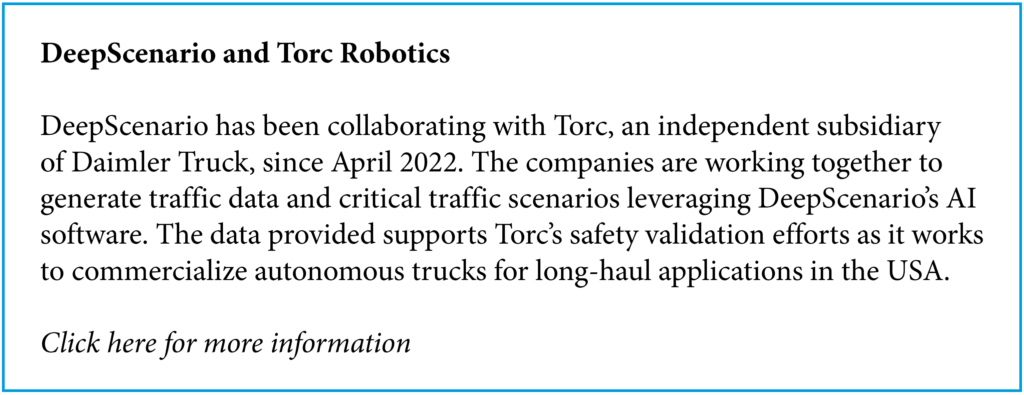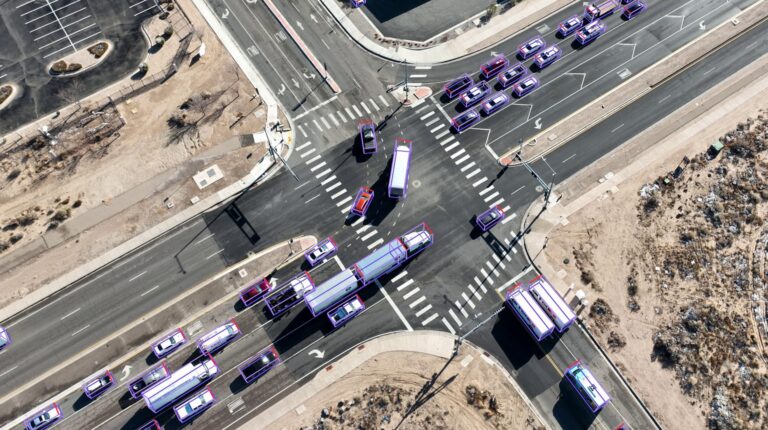 Ahead of his joint presentation with Torc Robotics’ senior engineering manager, Dr Maximilian Köper, at ADAS & Autonomous Vehicle Technology Expo Conference in Stuttgart (June 4, 5 & 6), Dr Holger Banzhaf, managing director and co-founder of DeepScenario, talks to AAVI about how his company’s software can be used to link the real world with the virtual world to enable customers to deploy autonomous systems at scale more quickly and at a lower cost.
Ahead of his joint presentation with Torc Robotics’ senior engineering manager, Dr Maximilian Köper, at ADAS & Autonomous Vehicle Technology Expo Conference in Stuttgart (June 4, 5 & 6), Dr Holger Banzhaf, managing director and co-founder of DeepScenario, talks to AAVI about how his company’s software can be used to link the real world with the virtual world to enable customers to deploy autonomous systems at scale more quickly and at a lower cost.
Germany-based Banzhaf first encountered automated driving in 2014 during a semester at UC Berkeley in the US. Before co-founding DeepScenario, he worked as a research engineer at Bosch. He has already received various IEEE awards for his work in the AD field.
Please tell us about your company.
DeepScenario builds the essential link between the physical and the virtual world to enable training and testing of autonomous systems at scale. Our mission is to help customers deploy autonomous systems in dramatically less time and with less cost. Core of our solution is the AI Scenario Engine, which turns real-world measurements into virtual driving scenarios for hyperscale simulation.
DeepScenario was founded in 2021 and has its roots in cutting-edge research in computer vision, autonomous systems and artificial intelligence. The company secured a seven-digit funding round in 2022 to accelerate the development of its groundbreaking technology. We collaborate with leading companies in the field and are part of one of the biggest research projects in Germany on automated driving.
One of our recent milestones was the launch of our new web app, which allows users to explore the AI Scenario Engine and gives access to massive amounts of traffic data from around the world.
What’s different or unique about your AI Scenario Engine?
With the AI Scenario Engine, our customers experience a paradigm shift in the development of ADAS and AD functions. We enable them to build a continuous loop from capturing the physical world, understanding its dynamics and leveraging this knowledge to prove the intelligence and safety of their systems. Core of this solution are AI algorithms that process large-scale traffic observations from any location in the world, extract real-world distributions and convert this knowledge into simulation-ready scenarios. To achieve scalability and automotive-grade accuracy, we leverage monocular cameras together with 3D computer vision to generate a high-fidelity, dynamic reconstruction of the world. Adding our scenario mining and scenario generation capabilities, our customers can test their systems against real-world edge-case scenarios and analyze performance at the limits of the possible.
In addition to Torc Robotics, can you tell us about any other companies you work with and projects you’re working on?
We work with some of the most well-known companies in the world, including Bosch, Mercedes-Benz and Volkswagen. Our customers use our AI Scenario Engine for multiple use cases – for example, to validate their ADAS and AD stack, to obtain ground-truth data for perception and prediction evaluation, or to build AI simulations with vast amounts of real-world traffic data.
Furthermore, we at DeepScenario push the boundaries of research. For instance, we are the only startup in STADT:up, one of the biggest research projects on urban mobility and automated driving in Germany. In another research project, ScenarioEye, we collaborate with the Technical University of Munich to scale our 3D computer vision algorithms to traffic cameras.
 How do you see the future of simulation?
How do you see the future of simulation?
The importance of simulation will continue to grow as companies strive to reduce costs and time-to-market by driving less in the real world and more in simulation. This will require highly realistic simulators both in terms of traffic agent behavior as well as sensor simulation. Right now, however, many simulation providers offer solutions with handcrafted, model-based algorithms that often produce unrealistic results. This can only be overcome by AI, where the simulator is trained on real-world data to achieve the realism required in the automotive industry. The key to developing such an AI simulation is the AI Scenario Engine that provides the data required to train and evaluate such a solution. I am convinced that the rise of AI will significantly transform the simulation landscape and requires existing players to adapt quickly in order to sustain their success.
Don’t miss DeepScenario’s Dr Holger Banzhaf and Torc Robotics’ Dr Maximilian Köper on Day 1 (June 4) of the conference (rates apply), which takes place alongside the free-to-attend ADAS & Autonomous Vehicle Technology Expo. Their presentation, ‘Accelerating the safe deployment of autonomous trucks’, is part of the ‘Issues, strategies and innovations driving and shaping the development and deployment of ADAS and AV technologies’ session. Click here to find out more



